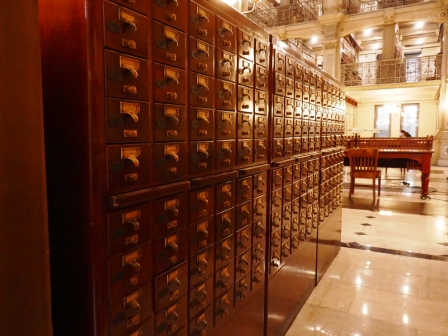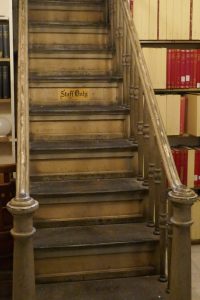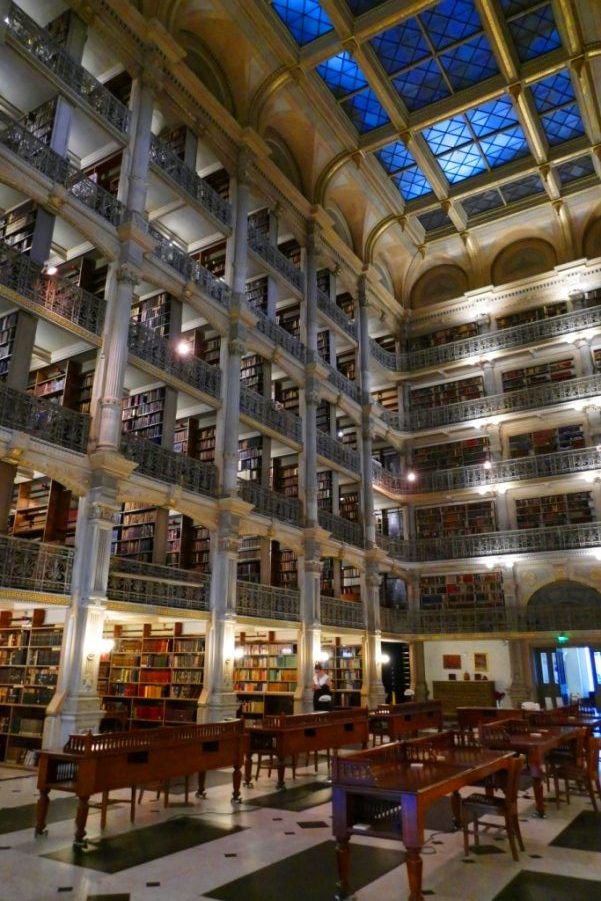“If you don’t go here while in Baltimore, your credentials as a librarian of any type will be revoked.” So wrote a friend upon learning that I would be attending the Special Libraries Association’s annual conference in Baltimore, Maryland, last week.
“Here” was the George Peabody Library.
The Peabody Library appears on many lists of most beautiful libraries in the world, which are absolute click-bait for library lovers. For example, have a look at:
- “22 Libraries Every Book Lover Should Visit in Their Lifetime”
- “The 8 Most Gorgeous Libraries In The World That Will Turn You Into An Instant Bookworm”
- “15 Of The World’s Most Beautiful Libraries That Are Too Good To Be True”
(Drool.)
By playing hooky from the conference for a couple hours, I was lucky to have a chance to visit, and the library did not disappoint.

Designed by Baltimore architect Edmund G. Lind and opened in 1878, the library is on the campus of the Peabody Conservatory of Music, now part of Johns Hopkins University.
The collection was donated by philanthropist George Peabody, “in appreciation of the ‘kindness and hospitality’ shown him by the citizens of Baltimore during his early career in dry goods and trade,” per the library’s website. Much to my delight, this turns out to be the same George Peabody with whom I’m familiar from London history studies, who created the Peabody Trust, which has long provided affordable housing in central London.
The Peabody Library’s main stacks room, which the first provost is said to have called “a cathedral of books,” contains six floors, five with decorative cast-iron balconies, reaching towards a skylight. (I noticed that the skylight looked blue in my photographs, though not in others online, so I was interested to read that it was in fact replaced in 2017 – perhaps with blue-tinted glass?).

It is, of course, a gorgeous space, and my own photos do not do it justice.
I didn’t have a formal tour, so I’m sure there’s lots more to learn, but here are some things that impressed me.
- The space felt welcoming, and not overwhelming. There was not the museum-like “touch me not” ambiance of other libraries on those most beautiful lists. The many alcoves on the ground floor, each with a long worktable, became quiet reading rooms, upon stepping out of the main atrium.
- The library is actually open to the public, though access to the stacks is restricted.
- You can rent the library for weddings and other events ($7,500 for a 4-hour booking on a Saturday in June). I noticed a pair of pianos. Do note that the following are not permitted in the library: “candles and open flames of any kind, balloons, birdseed, potted plants, smoking, bubbles, sparklers, beer kegs, drinking of shots, amplified music in the Exhibit Gallery.”
- The amount of detail in the building is astonishing, from the black and white marble floor, to the Greek key decorative borders, various floral motifs in the ironwork, the scallops on the columns, the gold trim reflecting the light, and that cathedral-like and glass-paneled ceiling … all just gorgeous.
Have a look at this wonderful 360 degree panorama view.
The collection contains around 300,000 volumes, mostly from the 18th and 19th centuries, although the library is still collecting. (The Ontario Historical Society’s library, by contrast, has about 5,000 volumes – and we too are still collecting – so now I can imagine the space requirements of a collection 60 times as large, wow.)
The library’s collections may be searched online, via the main Johns Hopkins Libraries catalogue (narrowing by location). You may also consult the library’s historic printed catalogue online at Internet Archive (see Volume One).
If you happen to be in Baltimore, I’d highly recommend a visit to the George Peabody Library, a truly stunning space.
Further information:
- Johns Hopkins Libraries website: Historic Collection at George Peabody Library and visiting hours and map
- George Peabody Library on Wikipedia
- Atlas Obscura article with many more photographs
If you found this post interesting, feel free to share it.

